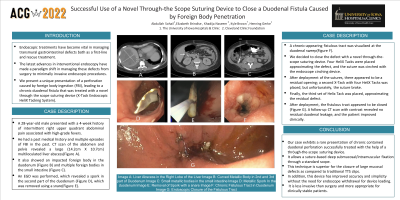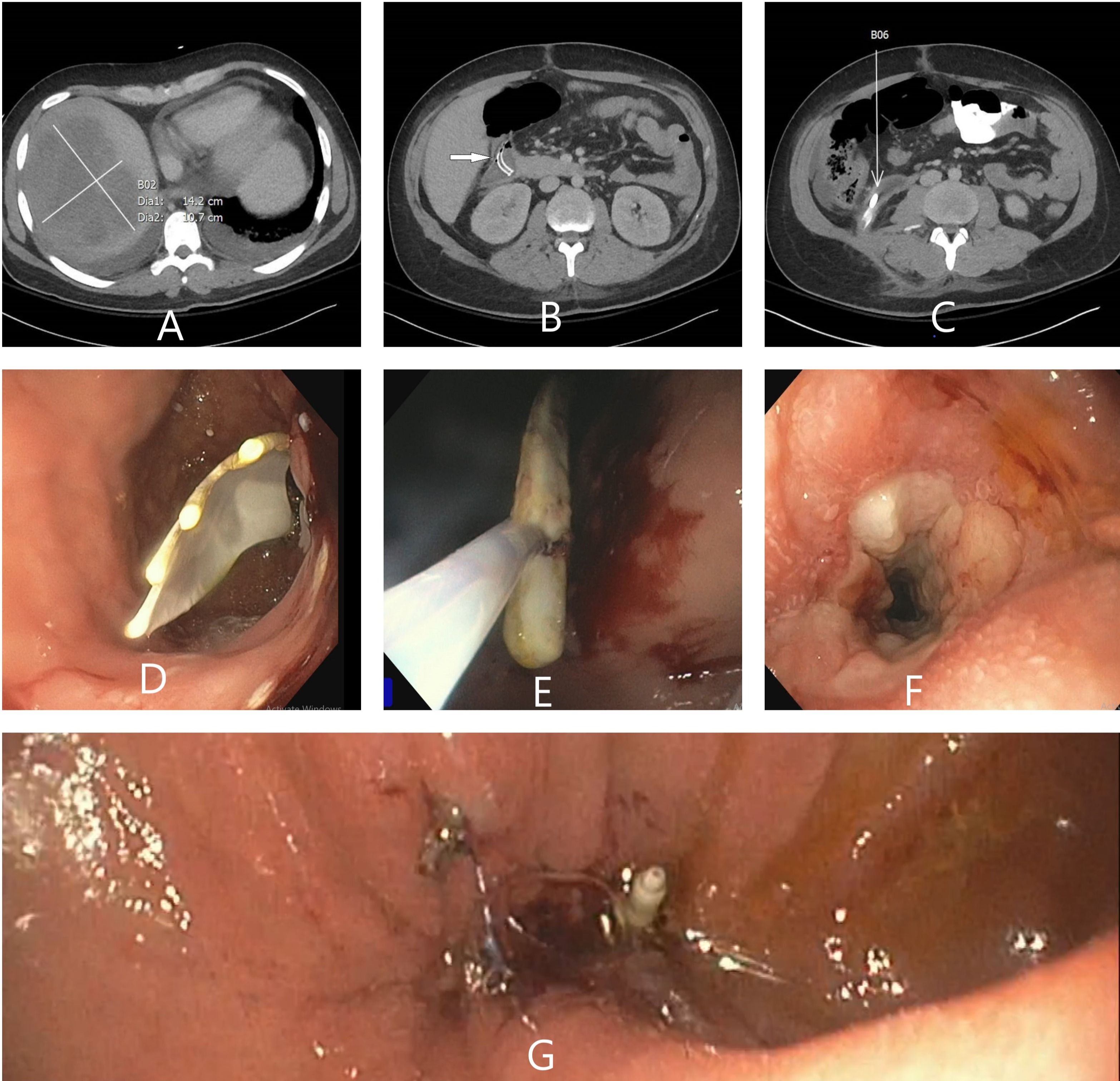Back


Poster Session C - Monday Afternoon
Category: Endoscopy Video Forum
C0197 - Successful Use of a Novel Through-the Scope Suturing Device to Close a Duodenal Fistula Caused by Foreign Body Penetration
Monday, October 24, 2022
3:00 PM – 5:00 PM ET
Location: Crown Ballroom

Has Audio

Abdullah Sohail, MD
The University of Iowa Hospitals and Clinics
Iowa City, IA
Presenting Author(s)
Abdullah Sohail, MD1, Khadija Naseem, MD2, Elizabeth Brindise, DO1, Kyle E. Brown, MD3, Henning Gerke, MD1
1The University of Iowa Hospitals and Clinics, Iowa City, IA; 2Cleveland Clinic Foundation, Cleveland, OH; 3University of Iowa Hospitals and Clinics, Iowa City, IA
Introduction: Endoscopic treatments have become vital in managing transmural gastrointestinal defects both as a first-line and rescue treatment. The latest advances in interventional endoscopy have made a paradigm shift in managing these defects from surgery to minimally invasive endoscopic procedures. We present a unique presentation of a perforation caused by foreign body ingestion (FBI), leading to a chronic duodenal fistula that was treated with a novel through the scope suturing device (X-Tack Endoscopic HeliX Tacking System).
Case Description/Methods: A 28-year-old male presented with a 4-week history of intermittent right upper quadrant abdominal pain associated with high-grade fevers. He had a past medical history and multiple episodes of FBI in the past.CT scan of the abdomen and pelvis revealed a large (14.2cm X 10.7cm) multiloculated liver abscess(Figure A). It also showed an impacted foreign body in the duodenum (Figure B) and multiple foreign bodies in the small intestine (Figure C). An EGD was performed, which revealed a spork in the second part of the duodenum (Figure D), which was removed using a snare(Figure E). A chronic-appearing fistulous tract was visualized at the duodenal sweep(Figure F). We decided to close the defect with a novel through-the-scope suturing device. Four HeliX Tacks were placed approximating the defect, and the suture was cinched with the endoscope cinching device. After deployment of the sutures, there appeared to be a residual opening; a second X-Tack with four HeliX Tacks was placed, but unfortunately, the suture broke. Finally, the third set of Helix Tack was placed, approximating the residual defect. After deployment, the fistulous tract appeared to be closed (Figure G). A follow-up CT scan with contrast revealed no residual duodenal leakage, and the patient improved clinically.
Discussion: Our case exhibits a rare presentation of chronic contained duodenal perforation successfully treated with the help of a through-the-scope suturing device. This novel technique has several advantages over the traditional through-the-scope (TTS) and over-the-scope clips (OTS). It allows a suture-based deep submucosal/intramuscular fixation through a standard scope. This technique is superior for the closure of large mucosal defects as compared to traditional TTS clips. In addition, this device has improved accuracy and simplicity without the need for endoscope withdrawal for device loading. It is less invasive than surgery and more appropriate for clinically stable patients.

Disclosures:
Abdullah Sohail, MD1, Khadija Naseem, MD2, Elizabeth Brindise, DO1, Kyle E. Brown, MD3, Henning Gerke, MD1. C0197 - Successful Use of a Novel Through-the Scope Suturing Device to Close a Duodenal Fistula Caused by Foreign Body Penetration, ACG 2022 Annual Scientific Meeting Abstracts. Charlotte, NC: American College of Gastroenterology.
1The University of Iowa Hospitals and Clinics, Iowa City, IA; 2Cleveland Clinic Foundation, Cleveland, OH; 3University of Iowa Hospitals and Clinics, Iowa City, IA
Introduction: Endoscopic treatments have become vital in managing transmural gastrointestinal defects both as a first-line and rescue treatment. The latest advances in interventional endoscopy have made a paradigm shift in managing these defects from surgery to minimally invasive endoscopic procedures. We present a unique presentation of a perforation caused by foreign body ingestion (FBI), leading to a chronic duodenal fistula that was treated with a novel through the scope suturing device (X-Tack Endoscopic HeliX Tacking System).
Case Description/Methods: A 28-year-old male presented with a 4-week history of intermittent right upper quadrant abdominal pain associated with high-grade fevers. He had a past medical history and multiple episodes of FBI in the past.CT scan of the abdomen and pelvis revealed a large (14.2cm X 10.7cm) multiloculated liver abscess(Figure A). It also showed an impacted foreign body in the duodenum (Figure B) and multiple foreign bodies in the small intestine (Figure C). An EGD was performed, which revealed a spork in the second part of the duodenum (Figure D), which was removed using a snare(Figure E). A chronic-appearing fistulous tract was visualized at the duodenal sweep(Figure F). We decided to close the defect with a novel through-the-scope suturing device. Four HeliX Tacks were placed approximating the defect, and the suture was cinched with the endoscope cinching device. After deployment of the sutures, there appeared to be a residual opening; a second X-Tack with four HeliX Tacks was placed, but unfortunately, the suture broke. Finally, the third set of Helix Tack was placed, approximating the residual defect. After deployment, the fistulous tract appeared to be closed (Figure G). A follow-up CT scan with contrast revealed no residual duodenal leakage, and the patient improved clinically.
Discussion: Our case exhibits a rare presentation of chronic contained duodenal perforation successfully treated with the help of a through-the-scope suturing device. This novel technique has several advantages over the traditional through-the-scope (TTS) and over-the-scope clips (OTS). It allows a suture-based deep submucosal/intramuscular fixation through a standard scope. This technique is superior for the closure of large mucosal defects as compared to traditional TTS clips. In addition, this device has improved accuracy and simplicity without the need for endoscope withdrawal for device loading. It is less invasive than surgery and more appropriate for clinically stable patients.

Figure: Image A: Liver Abscess in the Right Lobe of the Liver
Image B: Curved Metallic Body in 2nd and 3rd part of Duodenum
Image C: Small metallic bodies in the small intestine
Image D: Metallic Spork In the duodenum
Image E: Removal of Spork with a snare
Image F: Chronic Fistulous Tract in Duodenum
Image G: Endoscopic Closure of the Fistulous Tract
Image B: Curved Metallic Body in 2nd and 3rd part of Duodenum
Image C: Small metallic bodies in the small intestine
Image D: Metallic Spork In the duodenum
Image E: Removal of Spork with a snare
Image F: Chronic Fistulous Tract in Duodenum
Image G: Endoscopic Closure of the Fistulous Tract
Disclosures:
Abdullah Sohail indicated no relevant financial relationships.
Khadija Naseem indicated no relevant financial relationships.
Elizabeth Brindise indicated no relevant financial relationships.
Kyle Brown indicated no relevant financial relationships.
Henning Gerke indicated no relevant financial relationships.
Abdullah Sohail, MD1, Khadija Naseem, MD2, Elizabeth Brindise, DO1, Kyle E. Brown, MD3, Henning Gerke, MD1. C0197 - Successful Use of a Novel Through-the Scope Suturing Device to Close a Duodenal Fistula Caused by Foreign Body Penetration, ACG 2022 Annual Scientific Meeting Abstracts. Charlotte, NC: American College of Gastroenterology.
